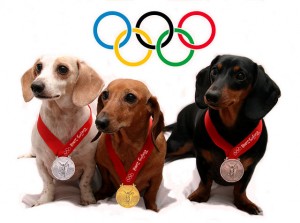 Watching the recent Summer Olympics was one of those guilty pleasures for me. Sneaking off to catch a look at kayaking or track and field is something I only get a chance to do once every four years. It’s inspiring to see the best athletes in the world competing in their chosen sports, win or lose. To develop skills to a high enough level to compete at the Olympic Games is more than most of us can hope to achieve. But strip away the human drama and the athlete’s story and what you have left is learned behaviour whether it is sprinting, paddling a kayak, or performing the high jump.
Watching the recent Summer Olympics was one of those guilty pleasures for me. Sneaking off to catch a look at kayaking or track and field is something I only get a chance to do once every four years. It’s inspiring to see the best athletes in the world competing in their chosen sports, win or lose. To develop skills to a high enough level to compete at the Olympic Games is more than most of us can hope to achieve. But strip away the human drama and the athlete’s story and what you have left is learned behaviour whether it is sprinting, paddling a kayak, or performing the high jump.
It might be difficult to explain how Olympic gold medal sprinter Usain Bolt developed his incredible speed and skills. It might be even more complicated to explain how he managed to repeat his gold medal performances in the 100m and 200m sprints from the previous Olympic Games in 2008. But Bolt himself credits the encouragement and inspiration of his high school track coach, Lorna Thorpe.
Oscar Pistorius of South Africa did not win a gold medal at the 2012 Olympics. But Pistorius made history at these Olympics. He was born without fibulas in his legs, that bone we call the “shin.” At 11 months of age, his legs were amputated below the knee. Now called the “Blade Runner” because of his prosthetic legs, Pistorius is the first double amputee ever to compete in the Olympics along side able bodied athletes. How does a double amputee achieve such a feat? By being brought up to be “completely normal” by his family. No one said “you can’t” to Oscar Pistorius.
How you get there matters
In my lifetime, I have been inspired by many such stories of achievement in sports, music, science, and many other fields. The theme that seems to run through all of these stories is the joy and confidence these high-achievers have in their endeavors. I never seem to read a story about a world class sprinter who got there by being threatened if he didn’t perform well. The best people in all kinds of activities seem to be the ones who had their own interests and abilities encouraged and refined by knowledgeable educators and trainers who rewarded their efforts.
I suppose that if someone pointed a gun at me, I would run faster than I have ever run in my life. But it’s not something I want to do every day. That wouldn’t be an experience I would look forward to repeating. But rest assured, every time someone pointed a gun at me, I would run as fast as I possibly could. It would be stressful and unpleasant, but I would perform.
And then there is the dog
“Sit”, “Down”, and “Come” will likely never become Olympic sports for our dogs. But we do have our own forms of canine sports like Obedience, Tracking, or Agility. How we train and the methodology we use to teach and work with our dogs does make a difference. Trainer and author Melissa Alexander’s wonderful article How You Get Behavior Really Does Matter talks about the pros and cons of different training approaches. Physical molding (touching the dog) will get different results from luring the dog with food or using shaping to get a behaviour. The methods we choose will depend on our knowledge and skills as trainers, the dog we are working with, and the kinds of results we are trying to achieve.
As mammals, our dogs do have their ideas and opinions of their world. How we go about teaching them behaviours and how we go about asking for those behaviours will have an impact on how they see us as their caretakers. That will matter more to some people than others, I suppose, but the fact remains that our behaviour will almost certainly influence our dog’s behaviour.
 Although training is a mechanical skill, the environment we create with our dog as we are training them can have a profound impact on their motivation for performing what we teach them. Just as our work environment can have an effect on our mood and quality of work, our dog’s “work” environment will effect them as well. Unfortunately for our dogs, they can’t always predict when they are “on the job” and when they are not.
Although training is a mechanical skill, the environment we create with our dog as we are training them can have a profound impact on their motivation for performing what we teach them. Just as our work environment can have an effect on our mood and quality of work, our dog’s “work” environment will effect them as well. Unfortunately for our dogs, they can’t always predict when they are “on the job” and when they are not.
Two roots of behaviour
Motivation gets to the heart of an important question; why is our dog responding when we ask them for a behaviour. So far as I have been able to discern, there are basically two primary reasons for our dogs to respond when we ask for behaviour. Our dog can perform as we ask for intentional reasons or they can do so for indirect reasons. Let me give you an example of what I mean.
If I have guests coming to my house for the weekend, I will spend a few hours cleaning bedrooms, bathrooms, the kitchen, etc. I will do a decent job and it will take a while. But I’m doing all that work for an indirect reason. I want to avoid the embarrassment of my guests seeing an untidy house. By contrast, I have friends who make a regular practice of keeping an orderly and tidy house. They do this intentionally because the rewards of living every day in a tidy home are enough to keep them happily cleaning.
I think dogs perform behaviours for either of the same two motivations. They either “sit” or “come” when we ask because they intend to or because they are indirectly trying to change something unrelated to the behaviour. While the resulting behaviour (i.e., the “sit” or “come”) may look very similar regardless of the dog’s motivation, what is actually going on can be different. That may affect the likelihood of our dog responding in the future, their willingness to work with us, or even the precision that they bring to that behaviour over the long term.
Intentions and alternatives
What I mean by intentional behaviours from our dogs is simply that the dog responds to our cues because they want to respond. The behaviour is rewarding to them. That reward may be a food treat, a pat on the head, a kind word, or a bit of play time with their human. It may even be the satisfaction of doing something they know well and have been rewarded for in the past. It is something offered by the dog with “no strings attached”; we ask, they respond. Good dog, here’s your reward!
Like my aversion to feeling awkward in front of guest in a messy home, indirect behaviours are performed to avoid something. If I ask my dog to “sit” and yank on his collar when he doesn’t, my dog may come to perform the “sit” behaviour promptly but he is doing so in order to avoid getting his collar yanked. So his performance is really just an indirect attempt to avoid something unpleasant. His mind isn’t really on the sit so much as avoiding the yank.
Another type of indirect behaviour is an “escape” behaviour. We ask our dog for a behaviour and, when they don’t comply, we start to move toward them or pull on the leash or poke them. In order to stop the unwanted thing we are doing, the dog will offer the behaviour you asked for to escape the unpleasant thing.
 But a “sit” is a “sit” is a “sit”, right? Well, maybe. Over time, indirect behaviours can vary slightly. Perhaps my dog learns that I will wait if he wiggles before sitting, that wiggle may become a strategy to get me to stop nagging him (“Sit! Sit! Sit!”) and still get a little time to finish sniffing. These changes can happen over a period of months or even years. And because they are an indirect strategy on the part of my dog, I may not even notice the change until his performance has become unsatisfactory for me. I’m left to wonder, “What’s wrong with this dog?” Maybe it’s the way I went about training him.
But a “sit” is a “sit” is a “sit”, right? Well, maybe. Over time, indirect behaviours can vary slightly. Perhaps my dog learns that I will wait if he wiggles before sitting, that wiggle may become a strategy to get me to stop nagging him (“Sit! Sit! Sit!”) and still get a little time to finish sniffing. These changes can happen over a period of months or even years. And because they are an indirect strategy on the part of my dog, I may not even notice the change until his performance has become unsatisfactory for me. I’m left to wonder, “What’s wrong with this dog?” Maybe it’s the way I went about training him.
A rose is a rose except when it’s not
I can learn to put my feet in the right places in time to the music, but that doesn’t mean I’m dancing. I may look like a great dancer but if my intentions are not there, I’m just going through the motions. The difference between me and Oscar Pistorius is that he wants to be running where I can only run that fast when my very life is threatened. If being forced into indirect behaviour to avoid something bad produced superior results, you would think there would be more than one starter pistol at the Olympics and that they would be pointed directly at the athletes!
Training our dogs shouldn’t just be about getting a result. There are lots of ways to get a result. Shouldn’t we be trying to get good results? It’s telling that athletes like Oscar Pistorius and Usain Bolt accomplished what they have because they were encouraged and rewarded for their efforts. I think it’s the same for dogs. If we teach, encourage, and reward our dogs will can get intentional behaviours that our dogs will want to give us for a lifetime. To me, that sounds so much better than my dog obeying me just to get me to stop being unpleasant.
Until next time, have fun with your dogs.
Check out my new ebook –
“Dogs: As They Are”
Photo credits –
Olympic Dogs –geckoam 2008 from Flickr
Suspicious – EH-RON 2011 from Flickr
Intentional Sit – bullcitydogs 2011 from Flickr

 In the Canine Nation Store!!!
In the Canine Nation Store!!!

[…] transcript of the main text of World Class Dog Behaviours is available at the Life As A Human online magazine website. You can visit Life as a Human to […]